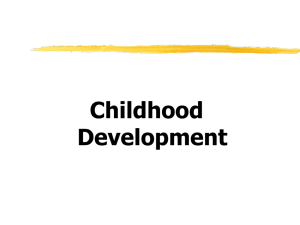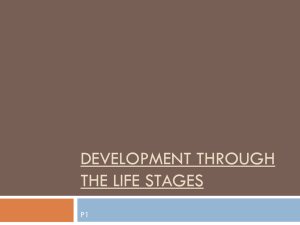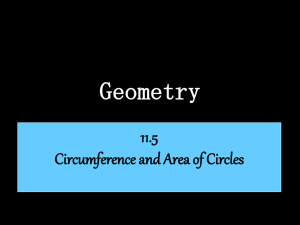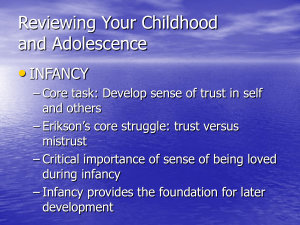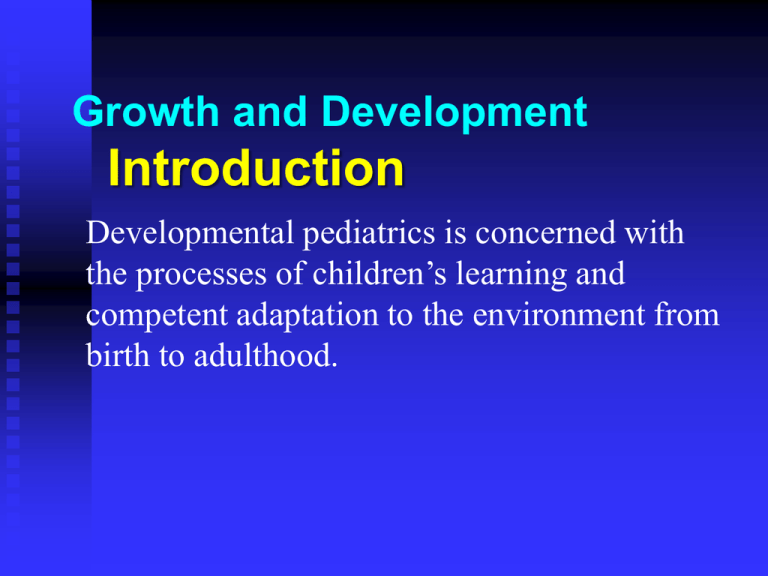
Growth and Development
Introduction
Developmental pediatrics is concerned with
the processes of children’s learning and
competent adaptation to the environment from
birth to adulthood.
So by monitoring children we can assess the
procedure of growth and development such as the
formation of tissues; the enlargement of head, trunk,
and limbs; the progressive increases in strength and
ability to control large and small muscles; the
development of social relatedness, thought, and
language; and the emergence of personality.
The context for observing a child’s development is the
family, school and community. Family, educational,
social, cultural, spiritual, economic, environmental and
political forces act favorably or unfavorably, but always
significantly, on the health and functioning of children.
Childhood marks the change from the entirely dependent
baby into the mature independent adult. During this
period the child:
•builds up a store of knowledge about the environment;
•learns motor skills to survive;
•learns a language with which to communicate and think;
develops a sense of self, self-regulation of emotions and
behavior and the coping strategies for successful
interpersonal relationships.
Definitions:
n
Growth: increase in the size or dimensions; as
weight, height, skull circumference.
is the increase in size and number of cells in
certain tissues.
n
Development: Functional maturation of
organs i.e. to acquire skill, learn and to adapt
to stress.
the normal process of maturation of functions.
Stages Growth and Development
Intrauterine:
Embryonic period
F
!st trimester (organogenesis)
u
Fetal period:
u
2nd
u
n
trimester (more in length)
3rd trimester (more in weight)
u
u
n
Infancy:
u
Early Neonate: Birth to 1 week
u
Neonate: Birth to 1 month
Infancy : Birth to 1 year
u
u
n
Toddler : 1-3 years
Preschool: 3-6 years
Middle Childhood
u
Extratrauterine:
n
Early Childhood
School age
6 to 12 years
Late Childhood
u
u
Adolescent
13 -18 years approximately
Factors affecting Stages of Growth and
Development
n
n
n
n
n
n
n
n
Genetic factors: racial & genetic.
Nutritional factors: adequate nutrition:
Socio-economic factors: poverty & ignorance.
Environmental factors: general hygiene.
Endocrinal factors.
Sex differences.
Chronic diseases.
Emotional factors.
Growth Patterns:
4
8
12 16 years
Assessment of Growth
Weight: there is 5-10% loss of weight in the first 3-4 days,
regained back by 10 days.
-At birth 2.5-3.5 kg
-Triple Weight at 1 year
Later on: Wt is approximately calculated:
Weight = Age in years x 2 + 8 (kg)
-Length:
at birth 50 cm
- at 1year 75 cm - at 2 year 100 cm
Later on: Wt is approximately calculated:
Height = Age in years x 5 + 80 (cm)
Growth Curves
Wt in
Kg
95
75
50
25
Age in years
5
Principles of Growth and Development
n
n
n
n
Growth is an orderly process, occurring in
systematic fashion.
Rates and patterns of growth are specific to
certain parts of the body.
Wide individual differences exist in growth rates.
Growth and development are influences by a
multiple factors.
Principles Continued
n
n
n
n
Development proceeds from the simple to the
complex and from the general to the specific.
There are critical periods for growth and
development.
Rates in development vary.
Development continues throughout the
individual's life span.
Growth Patterns
n
n
The child’s pattern of growth
is in a head-to-toe direction,
or cephalocaudal, and
In an inward to outward
pattern called proximodistal.
Purposes of developmental
assessment?
n
n
Early detection of deviation in child’s
pattern of development
Domains assessed: cognitive, motor,
language, social / behavioral and adaptive
•to promote optimal physical and mental health and development for
all children, ]
•applying principles of prevention of impairment, wherever possible,
and to reduce disability and handicap.
•to ensure early diagnosis and effective treatment of impairments of
body, mind and personality;
•to discover the cause and means of preventing such impairments.
Method of studying growth
n
1- Cross - sectional: 2- Longitudinal: -
Measurements used in normal
growth :
1- Linear ;
a-height
b-length
c-sitting height
d-span
2-Weight
3-Circumference
a-head circumference
b-chest circumference
c-lower limbs
4-Skin & subcutaneous fat

